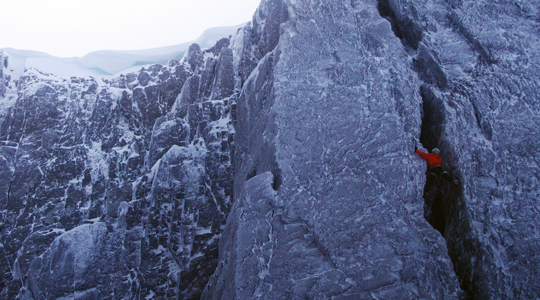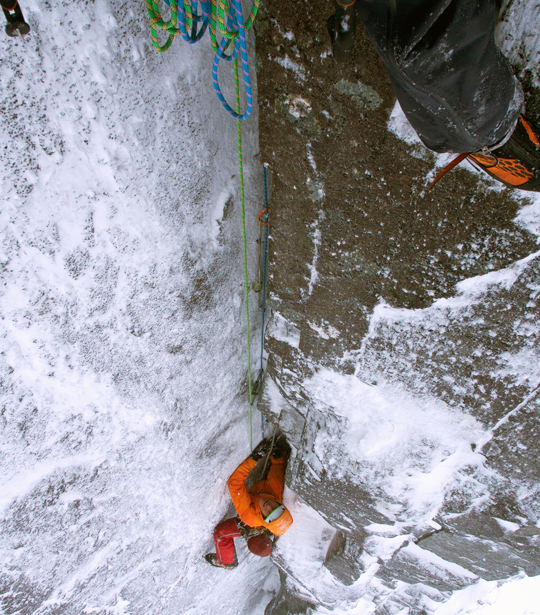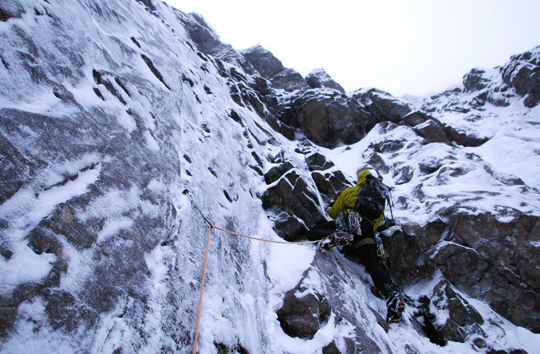
[Photo] Paul McSorley
“Miserable, wild and amazing,” said Calgary climber Jon Walsh as he described this season of Scottish mixed climbing. “The local code of ethics doesn’t allow bolting in the mountains so there’s a lot of really bold climbs, which a visitor like myself can really learn a lot from.” Insecure pick placements and poor protection are common on hard winter routes–something that local climber Dave MacLeod knows all about.
In mid-January, MacLeod–who has climbed up to E11 7a (similar to poorly protected 5.14 trad) and Scottish grade XI,11–completed the first winter ascent of Southern Freeze (IX,9; rated E2 5b in summer) on The Cobbler (850m; less commonly known as Ben Arthur) in the Arrochar Alps. Alpinist caught up with him to find out more.
[For an explanation of the Scottish winter grading system, check out this chart, courtesy of the American Alpine Club –Ed.]
Dave MacLeod’s First Winter Ascent on The Cobbler
The peak is named after its distinctive craggy skyline, which when viewed from the correct angle is said to resemble a cobbler leaning over his workbench. “It was an obvious winter line, being festooned with luminous lumps of moss and turf,” MacLeod wrote on his blog of Southern Freeze.
MacLeod’s first attempt on Southern Freeze was in 2007. “It took me around two hours…to climb the first 25 meters…I just didn’t have any more juice in the tank. I scraped about uselessly…then lowered off,” he said.
This season, when he arrived back at his highpoint on Southern Freeze, MacLeod climbed through the crux bulge without incident. He found hook placements more easily than he had on the previous attempt, and he soon reached the route’s first anchor. Leading the second pitch, he wrote, “I swung around an easy bulge and cruised up the much easier corner above, taking in the spectacular afternoon light looking down the Clyde and across to Ben Lomond.”

[Photo] Paul McSorley
The day after Southern Freeze, MacLeod attempted the second winter ascent of Mammoth (IX,9, four pitches, Boswell-Robertson 2010) on the front face of The Brack, also in Arrochar.
MacLeod said he didn’t look close enough at the route’s line before he began. He soon learned that he’d skipped the first 30 feet of the route’s first pitch, which was left of his start. He continued on anyway, climbing a corner to a steep crack plastered with rime, which offered difficult pick placements. He successfully completed the remainder of the four-pitch route. “Mammoth is a fantastic pumpy line and quite low stress since its well protected. Southern Freeze [however,] was a good bit harder,” he said.

[Photo] Paul McSorley
Canadians Repeat Hard Routes at Ben Nevis and Glen Coe
Jon Walsh’s recent visit was a return trip. “I came back to Scotland because the spirit of climbing here is strong,” he said. Walsh joined a group of Canadian climbers–including Paul McSorley, Marc-Andre Leclerc, Paul Bride, Ian Welsted and Michelle Kadatz–to sink ice tools into frozen turf, ice-rimed rock and frosted cracks in Scotland. The Canadians repeated several hard routes up to X,10, despite experiencing slab avalanches, hundred mile-per-hour winds and driving rain.
During his visit, Walsh successfully repeated Knuckleduster (VIII,9, 120m, 4 pitches, Ashworth-Fyffe, 2007), on Ben Nevis (1343m), the highest mountain in Britain.
[Read about the first winter ascent of Knuckleduster–Ed.]
Knuckleduster’s crux second pitch follows a traverse and includes corner, face and arete climbing. The pitch was white with rime and coated in verglas, which made for difficult route finding and gear placements. “I was never quite sure whether or not I could trust my gear, although judging by how hard it was for Michelle (Kadatz) to clean, it must’ve of been adequate,” Walsh wrote on his blog.
Midway through the crux on Knuckleduster, Kadatz thought he would fall and zipper out all his gear, and potentially slam onto the belay. “I thought he was going to rip the belay out,” Kadatz said. “So I slung a horn to back up the pitons and hexes,” she wrote in an email to Alpinist.
For Paul McSorley, finding solid gear placements in the icy cracks proved difficult. “Cams came in handy the odd time, but if the cracks were verglassed or rimed up, they would rip out with a test pull. Almost every passive piece of pro I placed needed a bit of ‘encouragement’ from the hammer,” he said. McSorley took two sizable falls during his trip, both onto hammered-in nuts, which caught him.

[Photo] Paul McSorley
Challenging Conditions Cut Climbs Short
“I’ve spent nearly two years of my life in Patagonia and the two weeks in Scotland offered conditions comparable to the worst I’ve ever seen,” McSorley said about his visit. “[The Scottish] weather shut us down several times, with high winds up to 120 miles per hour. The joke was they would ‘taper’ in the afternoon to 90 miles per hour. The wind, wet snow and heavy snow or a combination of all three [stopped us] before or during climbing on several outings.”
Warm, wet weather forced the climbers to wait for several days for the right conditions. “It was often too mild,” McSorley said. “When this happens, the ice and rime go, the turf thaws and the cliffs are considered out of condition [for winter climbing]. Frozen turf needs to be just that–frozen. When your pick rips out of the turf, the route is not [ready]. When it’s in ‘good nick,’ frozen turf can be that Thank God Jug you need to make the next move.”
Snow on the higher elevations of the cliffs also posed a threat to the climbers. While rappelling off after climbing the Sioux Wall (VIII,8) with Marc-Andre Leclerc, McSorley triggered a slab avalanche that knocked him off his feet while still roped. McSorley’s prusik back-up prevented him from being dragged down by the slide.
Leclerc leads in full conditions on the Sioux Wall (VIII,8) on Ben Nevis. While rappelling the route, McSorley triggered a slab avalanche that knocked him off his feet. [Video] Paul McSorley
McSorley also attempted the imposing corner route The Unicorn (VIII,8) at Stob Coire Nan Lochan (800m) in Glen Coe with Ian Welsted. The pair climbed two pitches before retreating because of heavy falling snow and windy conditions. “One’s ability to get up climbs in the windy weather is directly proportionate to one’s own desire to do so,” Welsted said.
“Overall we’ve had a challenging winter season here in Scotland,” Simon Richardson, editor of scottishwinter.com, wrote in an email. “The Canadians’ visit was one of the highlights. The most outstanding new routes have been climbed by Iain Small– Shadhavar (VIII,9; E3 6a in summer, Fryer-Tess, 2013) and Gates of Paradise (VIII,8)–both in Glen Coe.”
On December 14 Iain Small and Uisdean Hawthorn ascended Shadhavar. The line follows a thin crack, described by Small on scottishwinter.com as “perfect pick width.”
Small and Murdoch Jamieson climbed the steep Gates of Paradise on February 10. The route goes up ice-coated slabs to a steep mixed section and a roof, finishing on icicles.